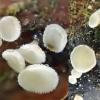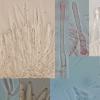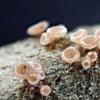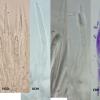
29-08-2025 05:16
 Francois Guay
Francois Guay
I think I may have found the teleomorph of Dendros

29-08-2025 19:04
Thomas FlammerSpores 21.2 - 26.2 x 8.3 - 11.3 µm - Q: 2.20 - 2.

28-08-2025 17:24
Thomas FlammerI know, that this is not the real topic of this fo

27-08-2025 12:02
Pavol PaloHello dear friendsI would like to ask for sharing

25-08-2025 17:37
 François Freléchoux
François Freléchoux
Bonjour,Nous avons trouvé samedi dernier à l'ét

20-08-2025 19:04
Ethan CrensonHello, This asco was found on the same wood as my
The hairs are clavate or sometimes tapering, with up to three septa, no droplets and 50-70 x 4-5 µ. The paraphyses have some barely discernible small droplets, the size is 70-90 x 4-6 µ in the living state and they have two or three septa in the lower third, protruding 15-25 µ above the ascus tips. The asci are 8-spored, 40-50 x 4-5 µ. The spores have some vaguely visible droplets and are (6.5) 7.2 - 9.3 (9.6) × (1.5) 1.7 - 2.4 (2.7) µm.
This leads me to Lachnum "subreynoutria". It is once mentioned on ascofrance:
http://ascofrance.com/search_forum/12116
Is the species better known now ten years later or is this someting else?

I have tried to find newer litterature but there seems not to be very many publications on new European Lachnum species or combinations, at least not anything of relevance for this case. I have mostly found only Asian papers, which I have not cheked out in detail.
Unfortunately I forgot the collection on the table to dry overnight, so now it is light brown. Anyhow, I made an attempt with KOH and CRB, photos attached. I also found a yesterday photo in water with paraphyses looking more alive.





